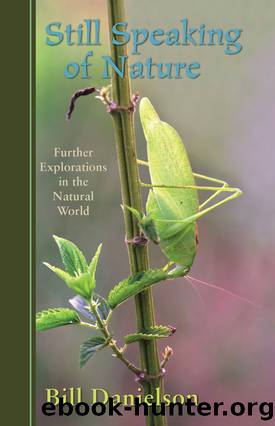Still Speaking of Nature by Danielson Bill;

Author:Danielson, Bill; [Danielson]
Language: eng
Format: epub
ISBN: 3407103
Publisher: State University of New York Press
Published: 2011-02-19T00:00:00+00:00
A male ruby-throated hummingbird feeds from a beebalm flower.
The antics that have proven most delightful, however, are those of the babies. Young hummingbirds are inquisitive and quite fearless, which makes them wonderful to watch. Hummingbirds in general seem so confident of their flying skills that they are willing to come quite close to people anyway. So, when you add in the factors of inexperience and being a little on the goofy side, young hummingbirds are a scream.
This male ruby-throated hummingbird declared
himself king of the feeders.
The most entertaining moments have been those provided by the young males. They are all practicing the territoriality that they will need as adults, and because they are so evenly matched, they spend what seem to be hours hovering, displaying, and chasing one another around. I think the abundance of food in the form of sugar water from the feeders has allowed them to spend more time playing than they would normally be able to.
But one of the young males seems to be making his mark, and he even dares to sit atop the potted fig tree that I have on my porch. This perch gives him a perfect view of the feeder and the comings and goings of any interlopers through his airspace. He is king of the roost until the adult male returns and soundly dethrones him with stunning swiftness. The old male is clearly in charge and exercises his will wherever and whenever he pleases.
For those of you who don't already know, the hummingbirds in our area are all of a single speciesâthe ruby-throated hummingbird (Achilochus colubris). Worldwide there are somewhere between 319 and 339 true species, and many hybrids.
All hummingbirds are found in the New World, and the majority of these species are found in the tropical regions of South America. There are only twenty-one species that can be found in the U.S., only eight that range up any distance from the Mexican border, and only three that can be found in Canada. Here in the Northeast there is only one species, the ruby-throated.
The name of our hummingbird comes as no surprise when you actually see a male. Hummingbirds have feathers that can refract light, giving them a decidedly metallic look. Their backs are the color of glimmering emeralds, and their throats, when seen in the proper light, flare up like burning rubies. Females lack the ruby throats, but keep the emerald sheen across their dorsal surfaces.
Ruby-throated hummingbirds are strongly attracted to the color red, which explains why so many hummingbird feeders have red plastic components, and why commercial hummingbird foods have red dye added to them. I will tell you now, however, that the commercial foods are expensive and not at all good for the hummingbirds because they often include preservatives that are harmful to adults and babies alike.
To make your own hummingbird food, mix one cup of boiling water with ¼ cup of white sugar. Let it cool to room temperature and then put it in your feeder. Remember to change the water every couple of days so that mold will not build up in the nectar.
Download
This site does not store any files on its server. We only index and link to content provided by other sites. Please contact the content providers to delete copyright contents if any and email us, we'll remove relevant links or contents immediately.
The Lonely City by Olivia Laing(4129)
Animal Frequency by Melissa Alvarez(3762)
All Creatures Great and Small by James Herriot(3527)
Walking by Henry David Thoreau(3238)
Exit West by Mohsin Hamid(3197)
Origin Story: A Big History of Everything by David Christian(3145)
COSMOS by Carl Sagan(2961)
How to Read Water: Clues and Patterns from Puddles to the Sea (Natural Navigation) by Tristan Gooley(2876)
Hedgerow by John Wright(2782)
The Inner Life of Animals by Peter Wohlleben(2776)
Origin Story by David Christian(2692)
How to Read Nature by Tristan Gooley(2669)
Project Animal Farm: An Accidental Journey into the Secret World of Farming and the Truth About Our Food by Sonia Faruqi(2668)
How to Do Nothing by Jenny Odell(2651)
Water by Ian Miller(2598)
A Forest Journey by John Perlin(2588)
The Plant Messiah by Carlos Magdalena(2458)
A Wilder Time by William E. Glassley(2367)
Forests: A Very Short Introduction by Jaboury Ghazoul(2337)
